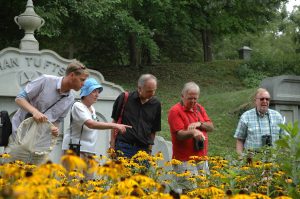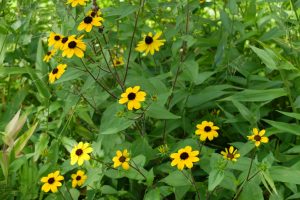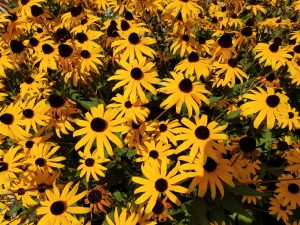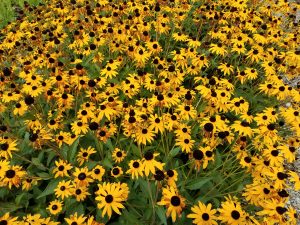Black-eyed Susan, Rudbeckia hirta
…was holding a black-eyed Susan,
talking about how the seed
this flower grew from
carried a message from a flower
that bloomed a million years ago…
-Marilyn Nelson
 Both Black-eyed Susan, Rudbeckia hirta and Orange Coneflower, Rudbeckia fulgida are some of the more recognizable and eye-catching flowers currently found throughout our landscape. These are superlative yellow/gold and black, or orange and black flowers which stand erect from 2 to 3 to 4-feet-high and usually remain in bloom from mid-summer right on into early autumn. These two, along with about two-dozen other different species of Rudbeckia are all North American native wildflowers. This genus is within the family ASTERACEAE, also called the COMPOSITAE, one of the largest families of flowering plants worldwide, with at least 1,335 genera and over 23,000 species. At Mount Auburn, we grow plants from well over twenty of these genera, including Echinacea, Chrysanthemum, Coreopsis, Zinnia, Dahlia, Cosmos, Aster, Solidago, Helianthus (sunflower), and Heliopsis (false sunflower) to mention a partial list.
Both Black-eyed Susan, Rudbeckia hirta and Orange Coneflower, Rudbeckia fulgida are some of the more recognizable and eye-catching flowers currently found throughout our landscape. These are superlative yellow/gold and black, or orange and black flowers which stand erect from 2 to 3 to 4-feet-high and usually remain in bloom from mid-summer right on into early autumn. These two, along with about two-dozen other different species of Rudbeckia are all North American native wildflowers. This genus is within the family ASTERACEAE, also called the COMPOSITAE, one of the largest families of flowering plants worldwide, with at least 1,335 genera and over 23,000 species. At Mount Auburn, we grow plants from well over twenty of these genera, including Echinacea, Chrysanthemum, Coreopsis, Zinnia, Dahlia, Cosmos, Aster, Solidago, Helianthus (sunflower), and Heliopsis (false sunflower) to mention a partial list.
 The Latin words that comprise binomial nomenclature may sometimes be unique, stimulating curiosity as to their meaning or source. A fair amount of these words originated from names of people. Rudbeckia is an illustrative example. Its source is Olof Rudbeck (1660-1740), a teacher at the Uppsala University, in Sweden, founded in 1477. In 1730, Rudbeck offered young Carl Linnaeus (1707-1778) a job tutoring three of his children. Linnaeus eventually would become the “father of taxonomy’s” system of binomial nomenclature, naming or re-naming many plants, and he conferred botanical immortality to his former employer and teacher. Andrea Wulf in The Brother Gardeners states, “For his old teacher Olof Rudbeck, Linnaeus chose the popular Rudbeckia. The tall flower reflected Rudbeck’s stature, Linnaeus explained, and the ray-like petals bore “witness that you shone among savants like the sun among stars.”
The Latin words that comprise binomial nomenclature may sometimes be unique, stimulating curiosity as to their meaning or source. A fair amount of these words originated from names of people. Rudbeckia is an illustrative example. Its source is Olof Rudbeck (1660-1740), a teacher at the Uppsala University, in Sweden, founded in 1477. In 1730, Rudbeck offered young Carl Linnaeus (1707-1778) a job tutoring three of his children. Linnaeus eventually would become the “father of taxonomy’s” system of binomial nomenclature, naming or re-naming many plants, and he conferred botanical immortality to his former employer and teacher. Andrea Wulf in The Brother Gardeners states, “For his old teacher Olof Rudbeck, Linnaeus chose the popular Rudbeckia. The tall flower reflected Rudbeck’s stature, Linnaeus explained, and the ray-like petals bore “witness that you shone among savants like the sun among stars.”
…and there’s pretty black-eyed Susan,
perfect as the night is blue…
-George Elliott Clarke
The colorful yellow/gold, and/or orange/gold, ray petals (daisy-like) serve to attract butterflies, bees and other pollinators to the slightly raised, black/brown, central cone, or disk. This flower disk/cone is comprised of scores of florets arranged in a spiral formation. Each floret contains its own stamens and pistils. During autumn, there are numerous species of birds that feed on the tiny seeds produced within these multiple disk florets, which remain even after all the ray petals have dried and fallen away, eventually providing erect, sculptural, winter interest above a snow-covered landscape.
 This genus of true meadow and prairie plants captivated the earliest European plant explorers. Rudbeckia laciniata, cutleaf coneflower was brought back to Europe from French Canada in the 1630’s. Rudbeckia hirta, black-eyed Susan was introduced into Europe in 1714, and was then taxonomically known as Obeliscotheca integrifolia radio aureo umbone atro rubente. Linnaeus in his 1753 landmark publication Species Plantarum, introduced the widely-accepted usage of binomial nomenclature to greatly simplify these previously long and cumbersome plant names. These and other Rudbeckia species became prized plants in early European, as well as American gardens, one and two centuries before Jacob Bigelow (1787- 1879), had visions of what was to become Mount Auburn Cemetery.
This genus of true meadow and prairie plants captivated the earliest European plant explorers. Rudbeckia laciniata, cutleaf coneflower was brought back to Europe from French Canada in the 1630’s. Rudbeckia hirta, black-eyed Susan was introduced into Europe in 1714, and was then taxonomically known as Obeliscotheca integrifolia radio aureo umbone atro rubente. Linnaeus in his 1753 landmark publication Species Plantarum, introduced the widely-accepted usage of binomial nomenclature to greatly simplify these previously long and cumbersome plant names. These and other Rudbeckia species became prized plants in early European, as well as American gardens, one and two centuries before Jacob Bigelow (1787- 1879), had visions of what was to become Mount Auburn Cemetery.
 Bigelow, physician, botanist and Harvard Medical School Professor for forty years, included a botanical description of Rudbeckia laciniata, cutleaf coneflower in his landmark flora of New England. In the 1840 Third Edition of Florula Bostoniensis. A Collection of Plants of Boston and its Vicinity [1814 First Edition], Bigelow wrote, “…A tall plant, resembling the sunflower. Stem erect, round, glabrous, six or eight feet high, branching. Leaves rough, the lower ones petioled, pinnate or pinnatifid with about five lanceolate, cut or toothed segments; upper ones nearly sessile, ovate or three cleft. Calyx mostly simple of about eight ovate, acute segments. Florets of the ray large, yellow, with their short segments. Disc conical, its florets greenish yellow, with their short segments erect or incurved. Receptacle large, down paleaceous, crenate. – Wet meadows on the Newbury turnpike. – August. – Perennial.” Bigelow included a twenty-five page glossary to assist those readers less conversant with botanical morphology.
Bigelow, physician, botanist and Harvard Medical School Professor for forty years, included a botanical description of Rudbeckia laciniata, cutleaf coneflower in his landmark flora of New England. In the 1840 Third Edition of Florula Bostoniensis. A Collection of Plants of Boston and its Vicinity [1814 First Edition], Bigelow wrote, “…A tall plant, resembling the sunflower. Stem erect, round, glabrous, six or eight feet high, branching. Leaves rough, the lower ones petioled, pinnate or pinnatifid with about five lanceolate, cut or toothed segments; upper ones nearly sessile, ovate or three cleft. Calyx mostly simple of about eight ovate, acute segments. Florets of the ray large, yellow, with their short segments. Disc conical, its florets greenish yellow, with their short segments erect or incurved. Receptacle large, down paleaceous, crenate. – Wet meadows on the Newbury turnpike. – August. – Perennial.” Bigelow included a twenty-five page glossary to assist those readers less conversant with botanical morphology.
Even earlier, Native Americans included these plants in their pharmacopeia. Cecil C. Still in Botany and Healing describes Rudbeckia hirta, black-eyed Susan being used, “…a root infusion was given to children for worms, taken for colds, and used as a wash for sores…root juice was used for earache and the tea taken for dropsy.” Look for Rudbeckia hirta, black-eyed Susan at Azalea Path at Willow Pond.
This brief look of Rudbeckia over the centuries comes right up to some contemporary garden designs, recalling prairie aesthetic, characterized by sweeps of grasses accented with these bold, late-blooming plant celebrities. One of the current favorites, Rudbeckia fulgida, var. sullivantii ‘Goldsturm’, orange coneflower was awarded the Royal Horticultural Society’s Award of Garden Merit in 1993. The same cultivar was chosen as the Perennial Plant Association’s Perennial Plant of the Year in 1999. On your next visit to Mount Auburn look for Rudbeckia ‘Goldsturm’ at and near Washington Tower, on the southwest side of Auburn Lake, as well as several other locations throughout our landscape.
I often reflect what a numerous train of yellow flowers your continent abounds.
-Peter Collinson (1694-1768)











Leave a Reply